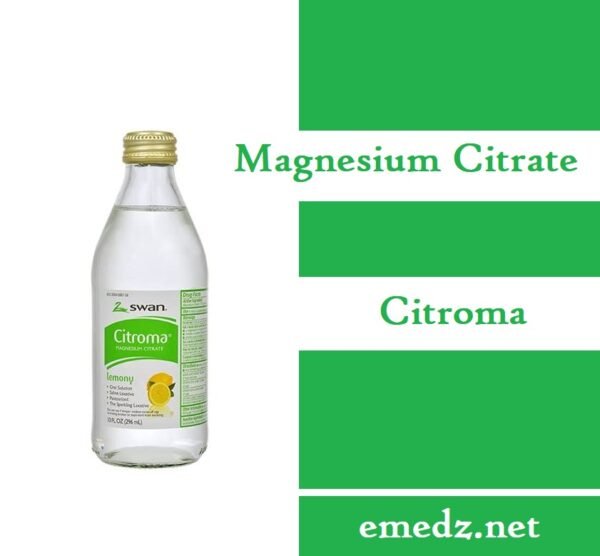Magnesium Citrate (Citroma) acts as an osmotic laxative. It is used in the treatment of patients with occasional constipation and may be used before a colonoscopic procedure for gut cleansing.
Magnesium citrate Uses:
-
Occasional constipation:
- For management of occasional constipation.
-
Off Label Use of Magnesium citrate in Adults:
- Used for gut preparation before procedure like colonoscopy.
Magnesium Citrate (Citroma) Dose in Adults:
Magnesium Citrate (Citroma) Dose in the treatment of Bowel preparation before colonoscopy (off-label):
Note: contraindicated in renal dysfunction, decompensated chronic liver disease, cardiac failure, metabolic and electrolyte imbalance.
-
Single-dose, same-day (for afternoon procedures):
- Oral: take 450ml 8 hours before the procedure. In the next 2 hours consume 3 240ml doses of clear fluids. Repeat 450 ml dose 4 hours before the procedure. Consume 3 doses of 240ml clear fluids over the next 1 hour.
-
Split-dose (the evening before the procedure):
- Oral: one day before the procedure, take clear fluids only. In the evening prior to procedure 450ml dose, consume 3 doses of 240ml clear fluid over next 2 hours.
- Repeat 450ml dose 6 hours before the procedure and 3 doses of 240ml clear fluid over the next 1 hour.
Magnesium Citrate (Citroma) Dose as Laxative:
- Oral: Solution: 200ml solution taken at once or in divided doses.
Magnesium Citrate (Citroma) Dose in Childrens:
Magnesium Citrate (Citroma) Dose in the treatment of occasional constipation:
Note: Due to the potential of developing electrolyte imbalance other laxatives such as PEG solutions and lactulose are more preferable.
Oral solution: Oral:
- Children 2 to <6 years:
- 60 to 90 mL taken at once or in divided doses.
- Children 6 to <12 years:
- 100 to 150 mL taken at once or in divided doses.
- Children ≥12 years and Adolescents:
- 150 to 300 mL taken at once or in divided doses.
Dose in the treatment of Bowel preparation:
-
Children >6 years and Adolescents:
- Oral solution: 4 to 6 mL/kg/day
- The maximum dose is 300ml/day, use as a single dose or in divided doses 24 hours prior to the procedure.
Pregnancy Risk Category: C
- Magnesium crosses the placental barrier. The serum levels in the fetus can be the same as the mother's.
- It can be used during pregnancy, but it is not recommended to use for prolonged periods of time.
Use during breastfeeding:
- Although breast milk contains magnesium, its concentration is independent of dietary intake.
Dose in Kidney Disease:
No dose adjustment required, however, due to renal excretion of magnesium, drug levels may increase in case of kidney dysfunction.
Dose in Liver disease:
No dose adjustment is required.
Side effects of Magnesium Citrate (Citroma):
-
Gastrointestinal:
- Abdominal pain
- Diarrhea
- Flatulence
- Nausea
- Vomiting
Contraindications to Magnesium Citrate (Citroma):
OTC labeling is not recommended for patients who are on a restricted diet.
Warnings and precautions
-
Constipation (self-medication, OTC):
- Appropriate use: do not use routinely. Only use with the advice of a doctor if you have pre-existing kidney disease, abdominal cramping, nausea, or vomiting.
- If you don't feel any bowel movements after using the product, stop immediately.
-
Neuromuscular disease
- If patients have a neuromuscular disorder such as myasthenia gravis, be sure to administer the medication carefully.
-
Renal impairment
- In the presence of renal dysfunction, magnesium accumulation and toxicity may occur. Be careful.
Magnesium citrate: Drug Interaction
|
Aluminum Hydroxide |
Citric Acid Derivatives may increase the absorption of Aluminum Hydroxide. |
|
Calcium Channel Blockers |
|
|
Neuromuscular-Blocking Agents |
Magnesium Salts may enhance the neuromuscular-blocking effect of Neuromuscular-Blocking Agents. |
|
Risk Factor D (Consider therapy modification) |
|
|
Alfacalcidol |
May increase the serum concentration of Magnesium Salts. |
|
Alpha-Lipoic Acid |
Magnesium Salts may decrease the absorption of Alpha-Lipoic Acid. AlphaLipoic Acid may decrease the absorption of Magnesium Salts. |
|
Bictegravir |
|
|
Bisphosphonate Derivatives |
Polyvalent Cation Containing Products may decrease the serum concentration of Bisphosphonate Derivatives. Management: Avoid administration of oral medications containing polyvalent cations within: 2 hours before or after tiludronate/clodronate/etidronate; 60 minutes after oral ibandronate; or 30 minutes after alendronate/risedronate. Exceptions: Pamidronate; Zoledronic Acid. |
|
Calcitriol (Systemic) |
May increase the serum concentration of Magnesium Salts. Management: Consider using a non-magnesium-containing antacid or phosphate-binding product in patients also receiving calcitriol. If magnesium-containing products must be used with calcitriol, serum magnesium concentrations should be monitored closely. |
|
Deferiprone |
Polyvalent Cation Containing Products may decrease the serum concentration of Deferiprone. Management: Separate administration of deferiprone and oral medications or supplements that contain polyvalent cations by at least 4 hours. |
|
Dolutegravir |
Magnesium Salts may decrease the serum concentration of Dolutegravir. Management: Administer dolutegravir at least 2 hours before or 6 hours after oral magnesium salts. Administer the dolutegravir/rilpivirine combination product at least 4 hours before or 6 hours after oral magnesium salts. |
|
Doxercalciferol |
May enhance the hypermagnesemic effect of Magnesium Salts. Management: Consider using a non-magnesium-containing antacid or phosphate-binding product in patients also receiving doxercalciferol. If magnesium-containing products must be used with doxercalciferol, serum magnesium concentrations should be monitored closely. |
|
Eltrombopag |
Polyvalent Cation Containing Products may decrease the serum concentration of Eltrombopag. Management: Administer eltrombopag at least 2 hours before or 4 hours after oral administration of any polyvalent cation containing product. |
|
Gabapentin |
Magnesium Salts may enhance the CNS depressant effect of Gabapentin. Specifically, high dose intravenous/epidural magnesium sulfate may enhance the CNS depressant effects of gabapentin. Magnesium Salts may decrease the serum concentration of Gabapentin. Management: Administer gabapentin at least 2 hours after use of a magnesium-containing antacid. Monitor patients closely for evidence of reduced response to gabapentin therapy. Monitor for CNS depression if high dose IV/epidural magnesium sulfate is used. |
|
Levothyroxine |
Magnesium Salts may decrease the serum concentration of Levothyroxine. Management: Separate administration of oral levothyroxine and oral magnesium salts by at least 4 hours. |
|
Multivitamins/Fluoride (with ADE) |
Magnesium Salts may decrease the serum concentration of Multivitamins/Fluoride (with ADE). Specifically, magnesium salts may decrease fluoride absorption. Management: To avoid this potential interaction separate the administration of magnesium salts from administration of a fluoride-containing product by at least 1 hour. |
|
Mycophenolate |
Magnesium Salts may decrease the serum concentration of Mycophenolate. Management: Separate doses of mycophenolate and oral magnesium salts. Monitor for reduced effects of mycophenolate if taken concomitant with oral magnesium salts. |
|
PenicillAMINE |
Polyvalent Cation Containing Products may decrease the serum concentration of PenicillAMINE. Management: Separate the administration of penicillamine and oral polyvalent cation containing products by at least 1 hour. |
|
Phosphate Supplements |
Magnesium Salts may decrease the serum concentration of Phosphate Supplements. Management: Administer oral phosphate supplements as far apart from the administration of an oral magnesium salt as possible to minimize the significance of this interaction. Exceptions: Sodium Glycerophosphate Pentahydrate. |
|
Quinolones |
Magnesium Salts may decrease the serum concentration of Quinolones. Management: Administer oral quinolones several hours before (4 h for moxi/pe/spar-, 2 h for others) or after (8 h for moxi-, 6 h for cipro/dela-, 4 h for lome/pe-, 3 h for gemi-, and 2 h for levo-, nor-, or ofloxacin or nalidixic acid) oral magnesium salts. Exceptions: LevoFLOXacin (Oral Inhalation). |
|
Tetracyclines |
Magnesium Salts may decrease the absorption of Tetracyclines. Only applicable to oral preparations of each agent. Exceptions: Eravacycline. |
|
Trientine |
Polyvalent Cation Containing Products may decrease the serum concentration of Trientine. Management: Avoid concomitant administration of trientine and oral products that contain polyvalent cations. If oral iron supplements are required, separate the administration by 2 hours. If other oral polyvalent cations are needed, separate administration by 1 hour. |
|
Risk Factor X (Avoid combination) |
|
|
Baloxavir Marboxil |
Polyvalent Cation Containing Products may decrease the serum concentration of Baloxavir Marboxil. |
|
Calcium Polystyrene Sulfonate |
Laxatives (Magnesium Containing) may enhance the adverse/toxic effect of Calcium Polystyrene Sulfonate. More specifically, concomitant use of calcium polystyrene sulfonate with magnesium-containing laxatives may result in metabolic alkalosis or with sorbitol may result in intestinal necrosis. Management: Avoid concomitant use of calcium polystyrene sulfonate (rectal or oral) and magnesium-containing laxatives. |
|
Raltegravir |
Magnesium Salts may decrease the serum concentration of Raltegravir. Management: Avoid the use of oral / enteral magnesium salts with raltegravir. No dose separation schedule has been established that adequately reduces the magnitude of interaction. |
|
Sodium Polystyrene Sulfonate |
Laxatives (Magnesium Containing) may enhance the adverse/toxic effect of Sodium Polystyrene Sulfonate. More specifically, concomitant use of sodium polystyrene sulfonate with magnesium-containing laxatives may result in metabolic alkalosis or with sorbitol may result in intestinal necrosis. Management: Avoid concomitant use of sodium polystyrene sulfonate (rectal or oral) and magnesium-containing laxatives. |
Monitoring Parameters:
Monitor magnesium levels in patients with kidney disease. In severe diarrhea, monitor electrolyte levels.
How to administer Magnesium Citrate (Citroma)?
Oral: administer cold solution with water.
Mechanism of action of Magnesium Citrate (Citroma):
It is an osmotic bowel laxative that promotes water influx into large intestine, distensioning it, and thus causing peristalsis.
The onset of laxative effect:
- Oral solution: 0.5 to 6 hours
Absorption:
- Oral: Up to 30%
Excretion:
- Urine; feces (as unabsorbed drug)
International Brand Names of Magnesium citrate:
- Citroma
- GoodSense Magnesium Citrate
- Argocytromag
- Citramag
- Epimag
- Magnesol
- Usanimals
Magnesium citrate Brand Names in Pakistan:
No Brands Available in Pakistan.




